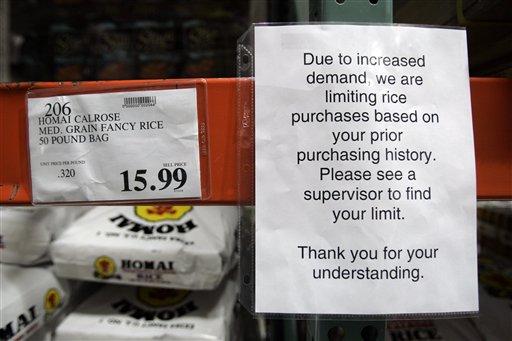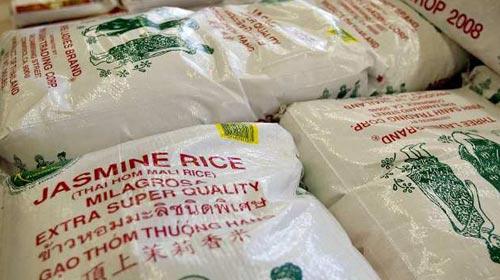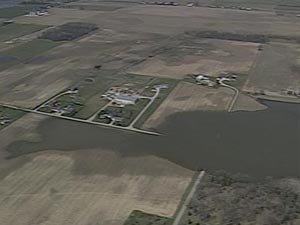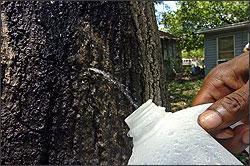Please do not reply to this Newsletter. You will likely get a response from a
machine, not Nancy! For feedback on the Newsletter or to correspond with
Nancy, click here instead.
Food Rationing
It was only a matter of time, given the food shortages and food riots that had
begun in Third World countries over the price and availability of rice, that
hoarding would begin. Hoarding has begun in US, considered the breadbasket
of the world, with Costco and Sam's Club forced to limit purchases of rice.

- Sam's Club, Costco Limit Rice Purchases
April 23, 2008
http://www.huffingtonpost.com/2008/04/23/sams-club-costco-limit-ri_n_98340.html
- The two biggest U.S. warehouse retail chains are limiting how much
rice customers can buy because of what Sam's Club, a division of
Wal-Mart Stores Inc., called on Wednesday "recent supply and demand
trends." The broader chain of Wal-Mart stores has no plans to limit
food purchases, however. The move comes as US rice futures hit a
record high amid global food inflation, although one rice expert said
the warehouse chains may be reacting less to any shortages than to
stockpiling by restaurants and small stores. Sam's Club followed
Seattle-based Costco Wholesale Corp., which put limits in at least some
stores on bulk rice purchases. Sam's Club said it will limit customers to
four bags at a time of imported jasmine, basmati and long grain white
rice.

Where the new rules apply only to rice, due to the global rice shortage, this is
the start of a trend, per the Zetas, that will only increase. The Zetas have
warned since the start of the ZetaTalk saga that times would come to this, as
they predicted that crop shortages would increase going into the pole shift. But
per the Zetas, hoarding is not the way to go as it is self defeating - giving a
false sense of security - and ultimately can result in trouble with the neighbors
and authorities.
ZetaTalk Prediction 11/15/1999: Many people view with alarm the thought
of food shortages and struggling with other people to wrest away a loaf of
bread or fist fights over a bag of flour or rice. They view with alarm such
thoughts, and their first thoughts are to stock up, to buy many of these items.
A case in point is the scare just years ago over toilet paper, where there was
purported to be a shortage of toilet paper. Suddenly all the toilet paper on
the shelves had been bought up. This is the first response to worry about
shortages, but there are many problems with this reaction.
Because the desire to hoard and stock up is anticipated by the authorities,
this is the first trend that will be watched and guarded against. Hoarding
cannot be disguised. The grocer knows who bought a large stock of food, and
neighbors can see who carried many groceries into a house. Those places
that sell large quantities of food such as rice or wheat or beans have the
person who made the purchase on record. One cannot hide a stock. The
police can come door-to-door, open the doors, and see a stock of food and
this stock can be confiscated. These stocks will be confiscated as food
shortages occur and hoarding is to be discouraged, so that fighting and
arguments and theft do not happen. The police will go door-to-door and
those people who have hoarded will have it taken from them, and this will be
distributed to others. Therefore, not only will they lose what they have tried
to gathered, they will be penalized. They will be fined, punished, maybe put
in jail, and certainly be scorned by their neighbors.
Nevertheless, the Wall Street Journal urged people to stock up their pantries.
Not bad advice, and not contrary to what the Zetas advised. Having a stock on
hand in case the grocery store is temporarily out or the weather prevents a run
to the grocery store is one thing. Hoarding, where you have a year's supply
stashed in the garage, is another.
- Load Up the Pantry
April 21, 2008
http://online.wsj.com/article/SB120881517227532621.html
- I don't want to alarm anybody, but maybe it's time for Americans to
start stockpiling food. No, this is not a drill. You've seen the TV footage
of food riots in parts of the developing world. Yes, they're a long way
away from the U.S. But most foodstuffs operate in a global market.
When the cost of wheat soars in Asia, it will do the same here. Reality:
Food prices are already rising here much faster than the returns you
are likely to get from keeping your money in a bank or money-market
fund. And there are very good reasons to believe prices on the shelves
are about to start rising a lot faster. You can't easily stock up on
perishables like eggs or milk. But other products will keep. Among
them: Dried pasta, rice, cereals, and cans of everything from tuna fish
to fruit and vegetables. The kicker: You should also save money by
buying them in bulk.
Food Prices
Shortages always incur rising prices, because of the law of supply and demand.
Price controls may ultimately be put into place to control price gouging, but
such price controls are usually part of the end game. Meanwhile, people starve.
- Is This The End Of Cheap Food?
April 23, 2008 04:24 PM
http://www.huffingtonpost.com/2008/04/23/
- A sharp spike in prices for wheat, corn, rice and other staples has
sparked riots in Mexico and Egypt, marches by hungry children in
Yemen and the specter of starving people in Haiti turning to mud pies
for sustenance. This growing unrest is forcing the global community to
focus on the causes of higher food costs and what can be done. But it's
also raising the troubling possibility that cheap prices for food may be
gone for good, an economic relic of the past. The gloom-and-doom
outlooks are prompted by rising prices for commodities, which started
increasing steadily in 2001 before suddenly soaring recently. Wheat
prices have gone up by 181 percent over the past three years, according
to the World Bank; food prices around the globe have risen by 83
percent during the same period. In March, rice prices hit a 19-year
high. Corn prices recently rose from $2.50 a bushel three years ago to
$6, for the first time.
For those countries pegged to the dollar, there is a double whammy, as the
dropping dollar means that less can be purchased with a dollar. Less food
available equates to higher prices. Less purchasing power for the dollar
equates to higher prices. The US is, of course, the main country pegged to the
dropping dollar. Rice is not the only crop rising in price and threatening
shortages. Corn, wheat, and soy are also in short supply and there are
repercussions up the food chain.
- Reduced Corn Crop Forecast Plants Fears
April 1, 2008
http://www.latimes.com/business/la-fi-corn1apr01,0,1787755.story
- The U.S. Agriculture Department sent shudders through much of the
food industry when it released estimates that showed farmers would
plant 8% less corn this year. With corn prices already pushing up food
prices the estimate bodes ill for consumers at the supermarket. Federal
energy policies that have created increased competition between the
nation's food producers and energy companies for corn. Competing
demands for farmland from high-priced wheat and soy crops also play
into reduced corn plantings. Farmers intend to plant 86 million acres
this year, 7.6 million acres less than 2007. Food producers are worried
about the decline because corn is a building block for a wide range of
foods. It is feed for dairy cows and egg-laying hens. It fattens cattle,
hogs and chickens. The acreage also has dipped because of the high
cost of the petroleum-based fertilizers and agricultural chemicals that
are used to grow corn as well as the standard practice of rotating crops
to sustain farmland. The current wet weather and flooding in the
Midwest could hamper or delay plantings of the grain and reduce the
amount that is harvested. Later in the year, heat and drought at the
wrong times could hurt the crop. Soybean producers intend to plant
74.8 million acres this year, up 18% from last year. Much of the
increase is a result of the run-up in soy prices in recent months. Wheat
acreage also is expected to rise this year, up 6% to 63.8 million acres.
The rising price of oil is also a factor, as oil is a component in fertilizer. Once
again, for those in countries pegged to the dollar, the price of oil is a double
whammy - partly due to the price set by oil producing countries, and partly due
to the dropping dollar.
- Oil Price Hits Record High 118.45 Dollars
April 27, 2008
http://afp.google.com/article/ALeqM5hw0Ys6GEmMlqqA2p9Z2FcR-xItqw
- Oil prices rocketed to historic highs above 118 dollars on Tuesday,
lifted by the tumbling dollar, unrest in Nigeria and OPEC's reluctance
to increase output. New York's main oil futures contract, light sweet
crude for delivery in May, jumped to an all-time high of 118.45 dollars.
The weak US currency makes dollar-priced commodities like oil
cheaper for foreign buyers and therefore tends to encourage demand.
The 13-nation OPEC, which produces 40 percent of the world's oil,
insists that there is no supply shortage in the market, with record prices
driven instead by speculative financial activity.
The Zetas, in the same breath when warning about hoarding, have advised
those taking their pole shift message seriously to become self sufficient by
growing their own food. At a minimum, get into gardening and seed saving
practices, and if possible maintain flocks and herds. Move from crowded city
living to rural locations, sparsely populated, where such practices are
possible. Such self sufficiency is the antidote to hoarding, which is self
defeating.
ZetaTalk Recommendation 11/15/1999: Anyone who has a stock of food who
does not find themselves at odds with the authorities will still be subject to
theft from gangs or hungry neighbors. In fact, it is as dangerous to stock up
and be traced as holding a hoard of food as it is for a rich man to walk with
gold jewelry down a dark path known to harbor thieves in the bushes. It is
almost a welcome sign, saying come take this from me. The word would go
out that this person or that person has a stock of food. Windows will be
broken and people will come in with bags over their heads so one doesn't
know who is taking the food stores away, and the person who has a lot of
stock will find it has been stolen from them. So, in the end, hoarding is not a
solution, even for those people who think they are clever and have very
carefully hidden their food. People who are starving and frightened will
aggressively attempt to find where the food has been buried.
It is much safer to be able to produce food on a regular basis. Those people
who have seed, or who know how to and are growing algae in water, for
instance, will find this cannot be readily taken or carried away. Growing
plants, algae or fish, cannot be carted away as easily as grabbing a bag of
rice or cans of food. Such food stuffs will spoil, are hard to catch, is wet,
smelly, and takes time. Those who are frightened or those who would steal
and rob are not inclined to spend the time to harvest. So somebody with
algae in a fish tank or gardens in their basement will find that it is not as
worthwhile for a thug or a hungry person to break into the basement to take
a tomato as it is to break into a garage where someone has stored many
sacks of flour or potatoes, something that is dry, compact, and easy to carry
away.
In addition, the person who is growing their own food regularly will find
that even should they be attacked by hungry people, that they will be able to
recover. Even should their hydroponics beds be ripped out and run off with,
with someone grabbing their carrots or tomatoes or cabbage or green
peppers or the fish in the tanks, they will have baby fish on the side to
restart their fish tanks and seed to restart their gardens. The person who has
just stored food cannot recover, and their food is usually gone. Therefore,
we recommend the capability of growing food, in many and varied ways to
where the cycle of life is at hand and a temporary disruption of a garden is
not a devastation. These people will not be raided. It will be the hoards that
will be raided. Therefore, we have encouraged growing seed and helping
people learn to grow, and helping people understand the simple things about
them with which they can feed themselves, such as insects and the foods
found in nature, the minimum that they need to survive. This kind of
knowledge is more valuable than bags of potatoes or barrels of wheat in the
garage, because knowledge cannot be taken from a person, and it is
therefore more valuable.
Aftershocks
Several aftershocks, at least two registering magnitude 4.5, followed the 5.2
quake along the Illinois border on April 21, 2008.
- Aftershock Reported Early Monday
April 21, 2008
http://www.county29.net/cms2/index.php?
- The U.S. Geological Survey says it has recorded one of the strongest
aftershocks so far from Friday's Illinois earthquake. Geologists say the
temblor just before 1:40 a.m. Monday, registered at 4.5 magnitude at
its epicenter about 5 miles northwest of Mount Carmel, Ill. The location
is in the same area as Friday's early-morning 5.2-magnitude
earthquake, which was followed by a 4.5 magnitude aftershock about
5½ hours later. The Monday morning aftershock was at least the 15th
since Friday's quake.
Has the pressure been relieved? Not according to some Bellevue, Ohio
residents. An aquifer, under pressure, has begun flooding a subdivision with no
end in sight.

- Bellevue Residents: Five Weeks of Freak Flooding and No End in Sight
April 18, 2008
http://www.wkyc.com/news/news_article.aspx?storyid=87593
- Beautiful weather, no river, no stream and yet almost a thousand
residents are coping with flood conditions. For some reason, the earth
in Bellevue continues to heave up millions of gallons of water to the
surface. Against gravity and against logic, the flooding continues day
after day. Homes and barns suddenly turned into islands trapped in
muddy water. No one knows why it began or when it will end. It is a
disaster for every homeowner for miles around Bellevue. The residents
north of town on state route 269 have especially been hit hard.
Scientists believe that underground artesian springs in the area
normally drain toward Sandusky Bay and Lake Erie. There are large
artesian springs at Miller's Pond, Green Spring, and Castalia, Ohio.
Affected residents suspect that someone who lives north of Bellevue on
State Route 269 might have plugged up sink holes that allow the
artesian water to vent naturally toward Lake Erie.
What does Ohio have to do with a quake on the Illinois/Indiana border? Per the
Zetas, the area under pressure is vast, reaching from the Great Lakes and New
England area down through the New Madrid Fault area to the Gulf Coast and
thence down to Mexico. The issue of aquifers under pressure in this region is
not new. It came up before near San Antonio, Texas in 2006.
- This East Side Tree Does its Own Watering
August 10, 2006
http://www.mysanantonio.com/news/metro/stories/
- The knotted, towering tree, more than 100 years old, has become the
root of scrutiny in the East Side San Antonio, TX neighborhood. The
tree has gurgled water from its trunk for the past three months. Answers
have been sought from several specialists - the Texas Forest Service,
the Edwards Aquifer Authority and nurseries. The water is cool, like it
came from a faucet. The flow is at a 10th or 20th of a gallon every
minute. Compared to Edwards Aquifer water, it the same as what comes
out of the tap. It could be a spring, but would be rare with the drought
conditions this summer. A science team member researched the
elevation of the area and said that it's unlikely that the water from the
tree is from aquifer spring flow. The source of the mysterious water
flow could be an artesian spring, a broken water pipe or an abandoned
well. Or possibly something else.

Per the Zetas, the cause of this mystery is indeed pressure on an aquifer.
ZetaTalk Explanation 8/16/2006: What is the relationship between quake
swarms in Oklahoma, sinkholes in Missouri, and a water tree in Texas? The
rock underlying this area is being stretched, fingers pulling apart so support
of the ground is lacking, and the ground sinks. As we have stated, stretch
zones do not experience large quakes, but the trauma is just as great as in
compression areas. Thus, the fact that this stretching and sinking is
occurring is missed until something dramatic occurs to hit the news. What
has caused an oak tree in the middle of a drought area to ooze water? What
happens to water under pressure? It seeks to escape, moving up when that is
the only avenue it can move. Tidal bore, where water rushes up a ravine well
above sea level because the pressure from the sea behind the tide is intense,
shows this to be the case. Water spews above ground when geysers blow
because of pressure, alone.
You received this Newsletter because you subscribed to the ZetaTalk Newsletter service. If
undesired, you can quickly Unsubscribe.
|

